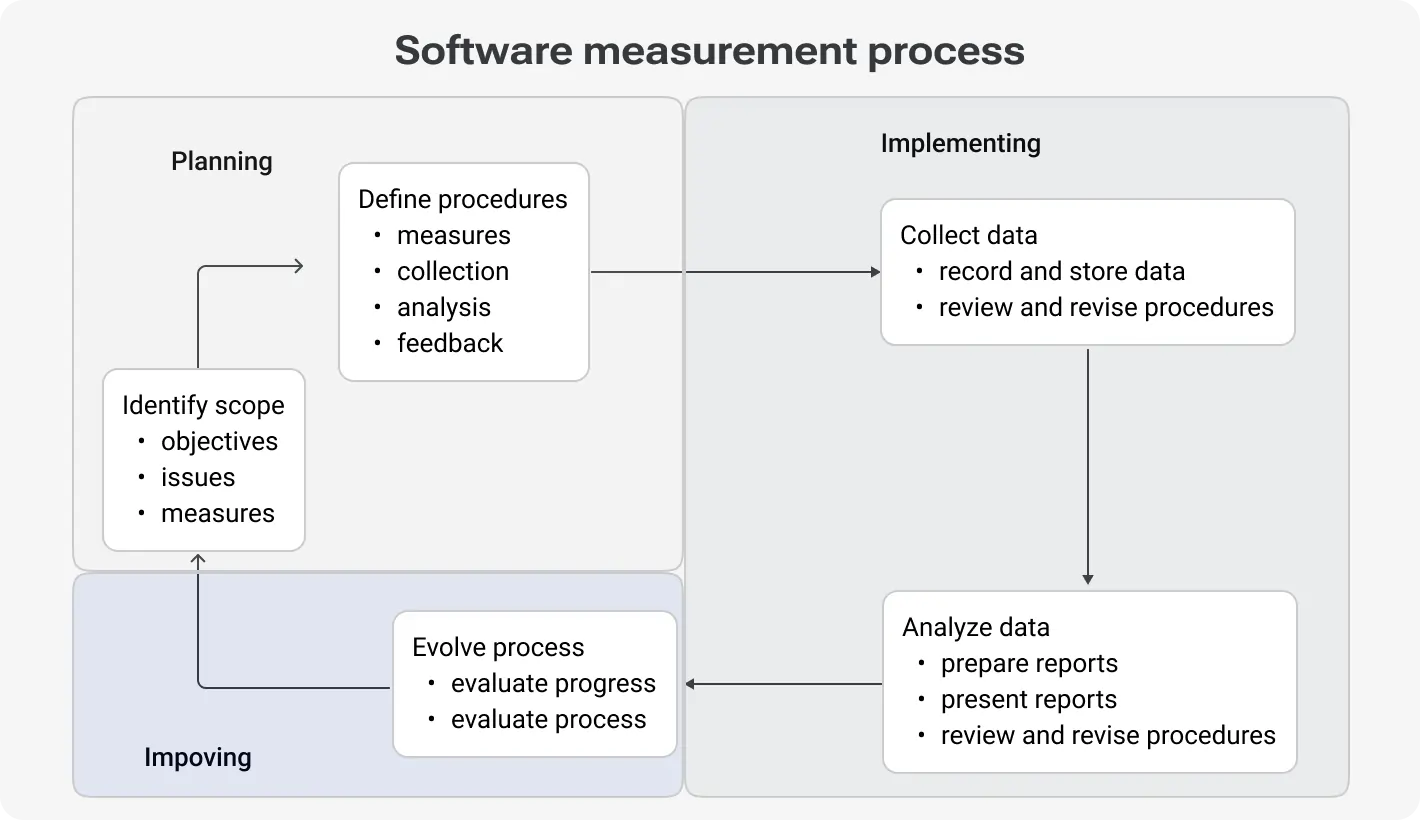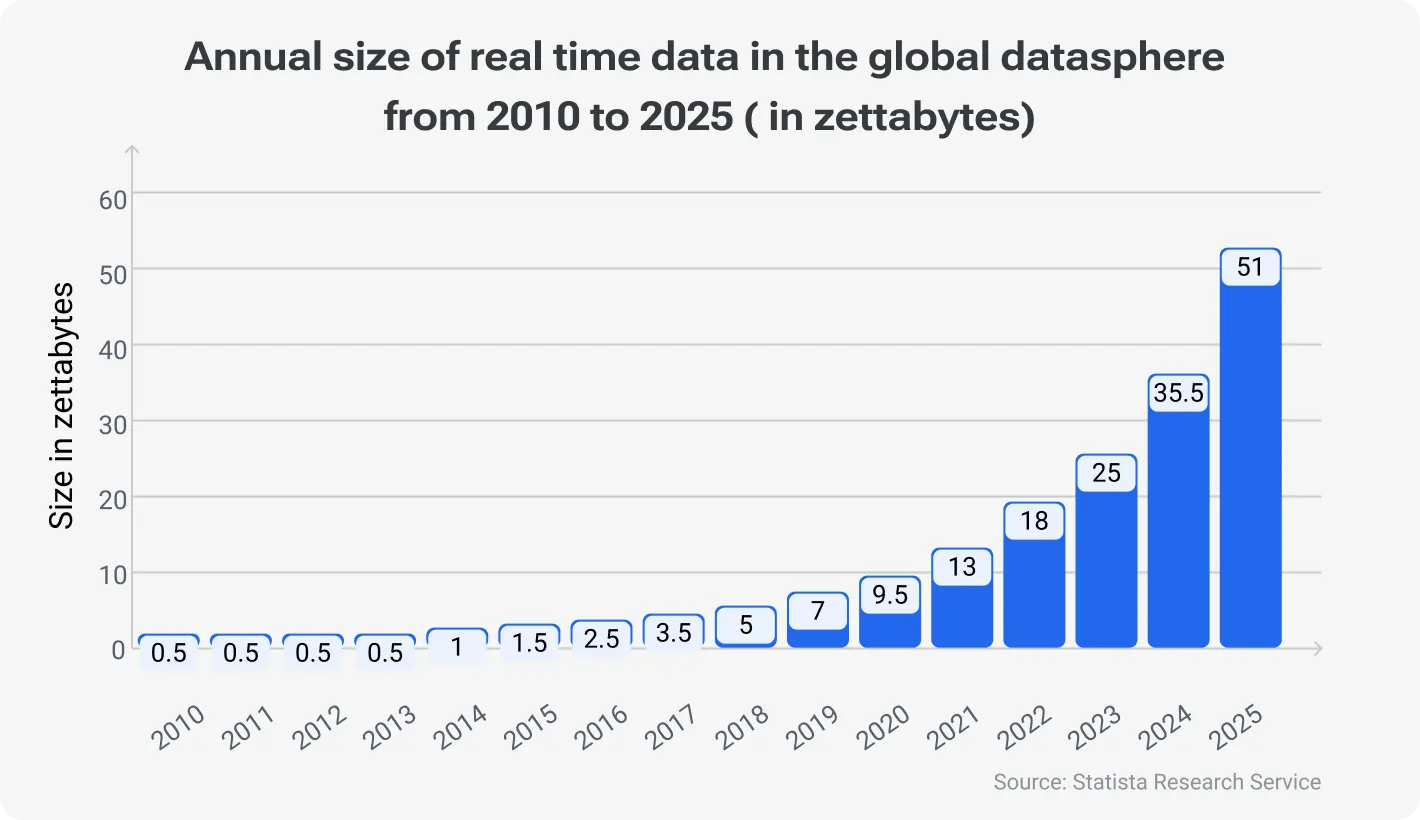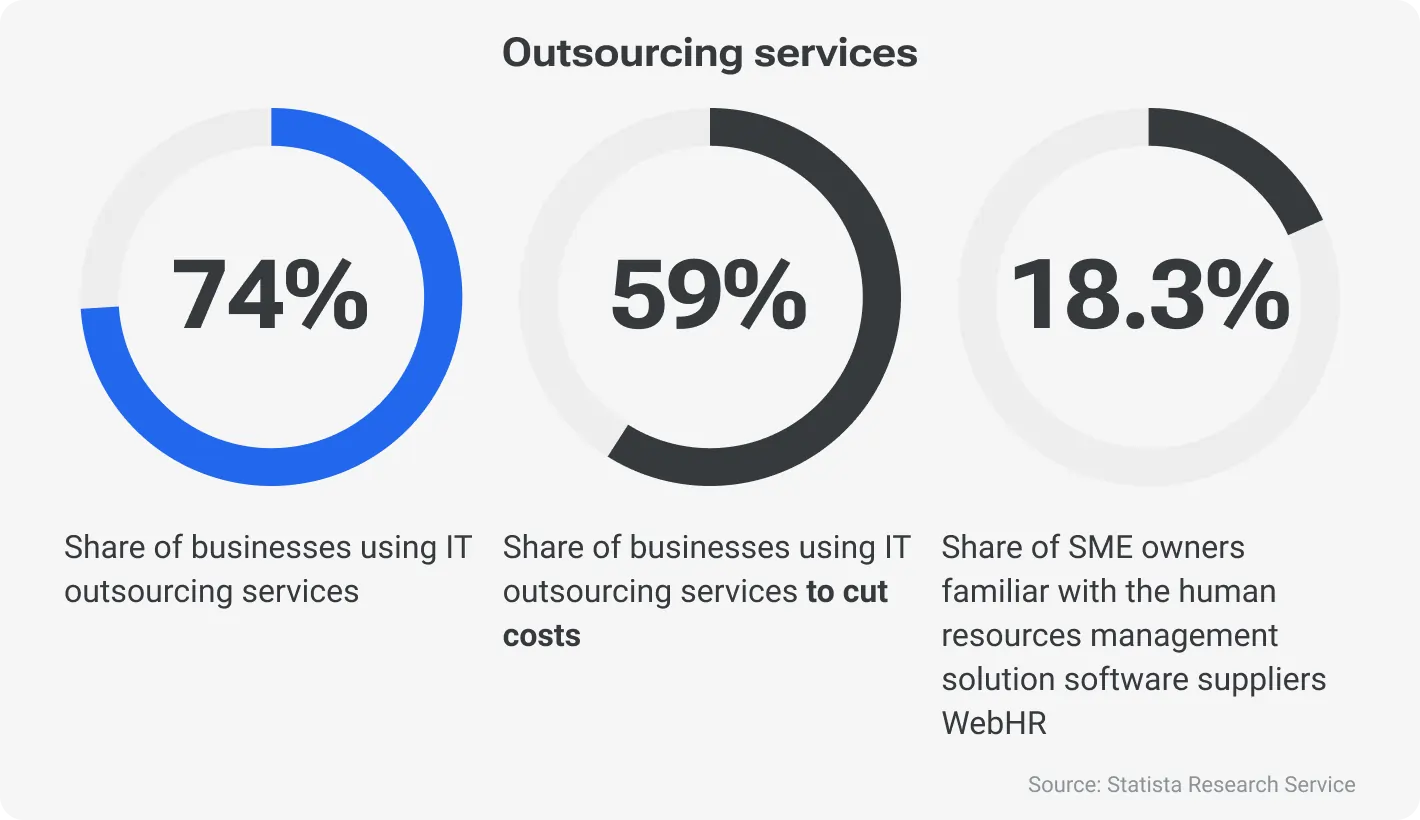Outsourcing to Czechia

How much does it cost to hire developers in Czechia?
Dec 2nd 25 - by Devico Team
Find out how much it costs to hire software developers in Czechia in 2025. Compare hourly rates, roles, and factors that impact pricing.
Hire
Hire by role
Hire Front-end developers
Hire Back-end developers
Hire Full-stack developers
Hire Android developers
Hire iOS developers
Hire Mobile developers
Hire AI engineers
Hire ML engineers
Hire Automation QA engineers
Hire Blockchain developers
Hire Data engineers
Hire Cloud engineers
Hire by skill
Hire JavaScript developers
Hire TypeScript developers
Hire Ruby on Rails developers
Hire React Native developers
Hire Flutter developers
Hire Golang developers
Hire React.js developers
Hire Python developers
Hire PHP developers
Hire .NET developers
Hire Java developers
Hire Laravel developers

Staff augmentation
June 04, 2024 - by Devico Team
Summarize with:
USD 60 billion per year. This is the consequence of poor-quality software development in the US. So, it is not groundbreaking that 62% of respondents agreed that tech businesses are hard to keep the high quality of the final product.
This fact underscores the importance of measurement in software engineering. Data-driven decisions have become the cornerstone of technological advancement and organizational growth.
Amidst this backdrop, the concept of outstaffing service – a model enabling businesses to seamlessly integrate skilled professionals into their existing teams to meet project demands – has surged in popularity. The global talent pool, flexibility, and scalability are just a few benefits of the outstaffing model.
Yet, simply deploying staff augmentation isn't enough. To ensure it delivers the intended value, measuring its success is essential.
Measuring the success of staff augmentation strategies, therefore, emerges as a non-negotiable pillar for CTOs and CEOs of SMEs.
If we focus on software measurement, all is clear.

But what and – most importantly – how to measure when it comes to cooperating with an IT outstaffing company?
This article delves into the key metrics essential for evaluating the success of staff augmentation in software development.
Talking about classic software measurement, we can cite the basic characteristics of each good separate gauging:
Reliability: The output of the estimation process must be accurate. Consistency in the results of the estimation process over time and across different scenarios is crucial.
Sensitivity: The estimating mechanism should reveal variability in responses when triggered by an event or occurrence.
Validity: The measurement process must accurately test what it claims to measure, ensuring its claims are valid.
But let’s back precisely to IT outstaffing metrics. They, too, serve as quantifiable measures designed to evaluate the effectiveness and efficiency of augmented staff within software development projects. These metrics act as quantifiable data points that provide insights into various aspects of your augmented team's performance.
Understanding relevant metrics is the foundation of performance evaluation in staff augmentation, ensuring teams contribute real value.
Are the augmented resources contributing effectively to project goals?
How well are the augmented team members collaborating with your internal staff?
Is staff augmentation delivering a positive return on investment (ROI)?
There are various types of staff augmentation KPIs, and endless ways to categorize them depending on your project needs. But typically, they fall into three categories: productivity metrics, quality metrics, and alignment metrics.
1. Productivity metrics: They define the output and efficiency of the augmented staff. Like the number of completed tasks, code commits per day, or features developed within a timeframe. Productivity metrics are particularly useful in projects where output volume and speed are critical indicators of staff augmentation performance — in high-competitor niches or with a hyped feature (AI for now, for example). The most obvious benefit of tracking such metrics is optimizing resource allocation.
2. Quality metrics: Set the standard of augmented team’s work. Bug rates, code review metrics, and the stability of the software post-deployment — these ones are crucial in projects where compromised integrity and reliability of the software can play a dramatic role.
3. Alignment metrics: These are about how well the augmented staff’s efforts align with the project goals. Satisfaction surveys, alignment with project timelines, and contribution to innovation — this kind of thing. Alignment metrics are indispensable in long-term projects or those requiring high levels of collaboration and innovation.
It may sound surprising, but intuition matters. If you feel that an outstaffing company is doing well… Okay, jokes aside. You, probably, have understood this already but just to clarify, effective decision-making requires measuring outstaffing success with data, not relying on intuition.
Above, we listed types of metrics. Now, let’s dive deeper into specific ones that are most useful when conducting a staff augmentation company evaluation and ensuring measurable value delivery.
Cost savings: The simplest yet one of the most important metrics. It compares the total cost of augmenting staff (including their rates, onboarding expenses, and any administrative costs) against the expenses associated with hiring full-time employees (salaries, benefits, taxes, workspace, and equipment).
Return on investment (ROI): This one quantifies the financial return from the investment in staff augmentation.
Cost per feature: This metric goes beyond simply comparing salaries and sheds light on the cost-efficiency of delivering specific functionalities within your software.
Completion rate vs. timelines: Project completion success can be expressed in a simple comparison: planned timelines vs. actual delivery dates. Find it by dividing the number of projects completed on time by the total number of projects, then multiplying by 100 for a percentage.
Quality score: Replace the defect rates with a broader Quality Score, which encompasses defect rates, client revisions, and adherence to specifications. Calculate it as a weighted average of these factors, with each being scored out of 10. This provides a more comprehensive view of the quality of outputs from augmented teams.
Project net profit margin: Provides a more comprehensive view of profitability by factoring in staff augmentation costs alongside traditional project expenses.
Client satisfaction index: Common practice is gathering client feedback. However, such a move doesn’t always bring about the insights you are looking for. There is a Client Satisfaction Index for that reason. You still should employ surveys but ask clients to rate their satisfaction with various aspects of the project on a scale of 1 to 10. The overall index is the average of these scores, providing a tangible measure of client satisfaction.
Knowledge enhancement factor: This replaces knowledge transfer and skill sharing, quantifying the degree to which the internal team has gained new skills or knowledge from the augmented staff. It can be measured through pre- and post-engagement assessments of team skills, with the factor being the percentage improvement observed.
Speed of onboarding: Measure the time-to-fill positions. Then — the Speed of Onboarding. Then just compare. These track the time from identifying a staffing need to having the augmented staff fully operational. Speed of onboarding is expressed in days and is critical for projects requiring rapid scaling.
Augmented staff retention rate: Just the retention rate of augmented staff.
If you find yourself among CEOs who throw caution to the wind, we are here to help. Our goal within this part is to show how tangible data can guide decision-making and strategy optimization.
The volume of data generated has seen exponential growth over the past years. Statista states the global data sphere is expected to grow to 51 zettabytes by 2025, up from 5 zettabytes in 2018.

Very remarkable shift toward more data-informed strategic decisions, innit? The least you can do is to analyze performance metrics to discern patterns and outcomes from previous staff augmentation engagements.
Clear success metrics for staff augmentation picture what's working and what isn’t, providing leaders with actionable insights. For example, if throughput metrics or quality scores are below expectations, it could indicate a need for better integration of augmented staff or more targeted skills matching. Pinpoint specific areas of underperformance and this way, you’ll be able to implement targeted improvements.
Whatever people say, true entrepreneurs know that ROI is the most robust indicator of success. In our case, ROI is one of the most reliable success metrics for staff augmentation, helping companies compare cost-effectiveness to other models. Such a comparison is vital for strategic planning, ensuring resources are allocated in a manner that maximizes value and aligns with organizational goals.
Relevant metrics can be compared to some sort of magic. They simply turn measurement into valuable insights and, hence, fruitful changes. For example, productivity metrics can reveal whether augmented staff are being underutilized or overburdened — and this, in turn, allows for adjustments in workload distribution or team composition.
The main goal of any business is to solve people’s problems and earn money for this. Client satisfaction surveys remain among the most valuable staff augmentation KPIs, directly reflecting perceived value and trust. They offer direct insights into the perceived value and quality of the work delivered through staff augmentation. Obviously, satisfied clients are more likely to return for future projects and refer others, driving your growth and revenue.
Every novelty brings resistance first. People would like not to change if they have a choice because changes disrupt safety. That’s why implementing metric tracking in software development projects when outstaffing and outsourcing requires a structured approach. Here's a step-by-step guide on how to make it softly and smoothly.
Before measuring success, it's crucial to define what success looks like for your project. Take advantage of frameworks like SMART and OKRs.
OKR (objectives and key results): This goal-setting framework outlines high-level objectives and measurable key results along the way.
SMART goals: States for specific, measurable, achievable, relevant, and time-bound. Ensure your goals fall into these characteristics.
These frameworks help to align the project's goals with measurable outcomes. They also ensure that all team members understand the goals similarly and are working towards them.
After you spelt out your objectives to yourself, select metrics that accurately reflect progress and success. Let’s give a simple example. You owe an EdTech business, and at the moment, your project's goal is to accelerate development time. So, it’d be better to focus on productivity metrics like throughput or time-to-deliver as they match your goal.
Before you decide how to measure staff augmentation, you need to know your starting point and establish a baseline. Collect baseline data to understand current performance levels:
Industry reports: Industry associations and research firms publish reports with benchmark data for software development projects.
Staff augmentation provider insights: Many reputable staff augmentation providers offer industry-specific benchmarks based on their project experience.
Internal project data: Take advantage of historical data from past projects (if applicable) to establish a baseline for comparison and track improvement over time.
Also, don’t forget about tools like Google Analytics, SEMrush, and Ahrefs. They can provide comprehensive benchmarks and insights into industry standards and competitors.
Once you have collected data, use tools like Tableau and Google Data Studio to visualize and analyze it. Tableau offers powerful data visualization capabilities that can help in identifying patterns, trends, and outliers in complex data sets. Google Data Studio provides a more accessible platform for creating custom reports and dashboards, making data analysis more intuitive and actionable for decision-makers.
To secure stakeholder buy-in, present hard data, because measuring outstaffing success is more convincing than intuition. And the tools mentioned above are the most valuable aider in this case. Use the data and analyses to inform stakeholders of the effectiveness of staff augmentation, but don’t hide imperfections. Take targeted actions to refine processes and address challenges.
How to get IT staff augmentation right
Those outstaffing services are good, which you can measure. And to manage it effectively, leverage the right tools and resources.
Asana: A versatile project management tool that allows teams to plan, organize, and track the progress of their work. It features task assignments, timelines, and progress tracking. Asana's dashboard provides a high-level overview of project milestones and tasks.
Jira: This tool was originally designed for software development teams. But for now, Jira serves any team that needs an effective and clear-cut tool for project management. It allows tracking issues and bugs, sprint planning, agile project management, detailed reporting and analytics, which can help in assessing the productivity and efficiency of augmented staff, as well as the quality of the output.
Toggl Track: It's invaluable for calculating productivity metrics and identifying areas where you feel a lack of efficiency. Its reporting features make it easy to visualize time allocation and productivity trends over time.
Harvest: Tools like Harvest simplify cost tracking while also providing insights into staff augmentation performance across tasks and projects. Its time-tracking functionality is instrumental in measuring the cost-effectiveness of staff augmentation by providing data on the actual hours spent on tasks and projects.
Slack: Very popular messaging app for over 750,000 companies. It integrates with many project management and development tools, making it a central hub for project updates, discussions, and team interaction. And probably the most important — it has custom stickers and reactions based on famous memes!
Microsoft Teams: Another MS tool that integrates with Microsoft 365. It offers chat, video meetings, file storage, and integration with other Office apps. Highly recommend installing the desktop software or at least using the latest web version.
Miro: A visual collaboration platform that functions as a digital whiteboard. It offers a virtual workspace where internal and augmented teams can brainstorm ideas, create mind maps, manage workflows, and collaborate visually on projects.
SurveyMonkey: Allows the creation of custom surveys for gathering feedback from clients, internal teams, and augmented staff. Measure satisfaction levels, gather feedback on the quality of work, and assess the effectiveness of communication and integration efforts with this tool.
Google Forms: Old but gold. Forms provide a straightforward way to create surveys and feedback forms, which can be easily distributed and analyzed. It's a cost-effective tool for collecting feedback on various aspects of staff augmentation, from the quality of deliverables to the effectiveness of collaboration processes.
Let’s face it, tracking any data requires additional attention and resources in general. But trust us, it will pay off a hundredfold since it can transform how your company manages and evaluates external talent. Take a closer look at the benefits you don’t want to miss.
A clear view on outstaffing services is paramount even if it still doesn’t offer the so-called helicopter view. This way, you ensure that all stakeholders have a shared understanding of what is being achieved. Moreover, such transparency holds both internal teams and augmented staff accountable for their responsibilities and deliverables.
By systematically measuring the outcomes of staff augmentation, you can validate the impact of your investment. This not only bolsters confidence in the strategic use of staff augmentation but also helps in demonstrating its value to skeptical stakeholders. With concrete data, DMs can make more informed choices about continuing or adjusting their augmentation approaches.
It’s pretty difficult to get somewhere if you are in the dark about where you want to get at the end of the day. Metrics tracking offers a map for your development journey using an outstaffing model. First, you set out the company’s objectives, and then pave the way toward them by leveraging concrete data. This alignment is critical for proving staff augmentation effectiveness and ensuring adequate resource allocation.
Regularly measuring and analyzing performance data encourages a culture of continuous improvement. It allows teams to identify not just areas of weakness but also opportunities for innovation and efficiency gains. This proactive approach to improvement, based on evaluating staff augmentation, can lead to breakthroughs in processes and products.
With firmly and constantly gauged metrics, you understand which part, feature, or attribute of your product must be improved. And what’s more important in our context — what’s the outstaffing company's role in this endeavor. Such information allows you to deliver higher-quality products and services. This, in turn, boosts client satisfaction. Hence, you increase revenue and build long-term relationships with your clients. That’s simple.
The main point of this article is that implementing staff augmentation metrics is highly beneficial and you definitely could do with it. But at the same time, this move comes with its set of challenges. What to be aware of?
Recent trends indicate a significant uptick in the use of the outstaffing model, particularly within the IT sector. To back up our words — take a look at Statista’s report. 59% of businesses globally have turned to outsourcing to cut costs.

It is great that companies are able to count money. Yet, there are still many companies that often grapple with effectively measuring the success of such engagements.
Selecting appropriate metrics tailored to specific project goals and niches is also the most critical step in staff augmentation company evaluation. Let’s run through some examples.
E-commerce startup (objective — to launch a new mobile app): Focus on project completion rate, time-to-market, and cost per feature to ensure timely app launch within budget and optimize development costs with staff augmentation.
FinTech company (objective — to implement a new security feature): Prioritize defect rates and rework needed on augmented team deliverables to guarantee high-quality code and minimize security vulnerabilities. Team productivity and knowledge transfer become crucial to ensure efficient feature development by the augmented team.
Healthcare provider (objective — to build a patient portal): Emphasize client satisfaction, communication effectiveness, and employee satisfaction to ensure a seamless user experience for patients while maintaining a positive working environment for both internal and augmented development teams.
The best practice in ensuring data consistency is establishing standardized procedures for data collection and tracking across all teams, including augmented staff. It’d be better to allocate some budget for specific tools in advance. Consequently, you also may need training sessions on using these tools.
Probably, you are gathering data across diverse platforms and tools. This is a significant hurdle. To address this, consider platforms like Zapier or custom APIs. This way, you’ll be able to automate data flow between systems, ensuring a cohesive dataset. Additionally, investing in business intelligence tools that can aggregate and analyze data from various sources can mitigate the challenges of data silos.
Outstaffing services metrics stand as a beacon for companies aiming to navigate the complexities of project management and team expansion. A well-structured approach not only illuminates the path to achieving project goals but also fortifies the decision-making process with data-driven insights.
Focus on ROI but also remember about time per feature and other important metrics that are relevant for exactly your business. The integration of precise, relevant metrics is a necessity for businesses seeking to maximize the value of their staff augmentation strategies.
By leveraging the right metrics, you can prove staff augmentation effectiveness, secure successful outcomes, and gain a competitive edge. The insights garnered from a well-implemented metrics system empower businesses of all sizes to make informed choices, optimize resources, and elevate their IT outstaffing engagements to new heights.
Outsourcing to Czechia

Dec 2nd 25 - by Devico Team
Find out how much it costs to hire software developers in Czechia in 2025. Compare hourly rates, roles, and factors that impact pricing.
Outsourcing to Czechia

Nov 25th 25 - by Devico Team
Compare Czechia and Poland for software outsourcing in 2025. Discover costs, talent, infrastructure, and which country fits your project best.
Outsourcing to Czechia

Nov 18th 25 - by Devico Team
A complete guide to outsourcing software projects to Czechia, learn about costs, talent, benefits, and how to build successful partnerships in 2025.